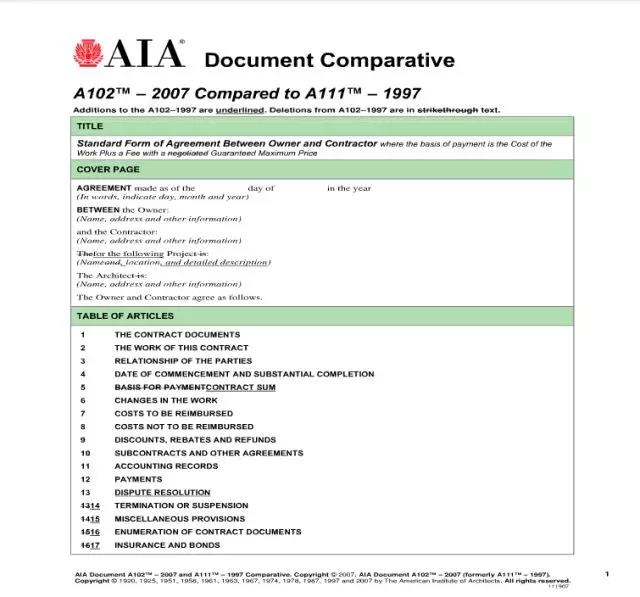导语:
聪明人解决问题,而天才阻止问题的发生。——爱因斯坦
译文:
商业建筑项目涉及到多方面的风险。比如:众多的缔约方,不稳定的材料价钱,潜在的缺陷,不可预测的地方政府,很紧的利润等使得它极具挑战性。因此,缔约各方需要一份精心起草的建筑合同。

过程
完成建筑合同的过程是很累人的。必要的步骤包括:选址、设计概念、规划和规范、工程估计、定价、修订、投标、延误和贷款谈判。甚至在第一份建筑合同草案生效之前,疲劳就会出现。陈旧的出价、过期的预计时间表和坚决破土动工的愿望都可能导致贸然签订合同的危险。
我们的建议是:慢下来。

到底什么可能出错呢?
一言以蔽之 【一切】!
不当区域规划、成本超支、边界线争端、计划和规范修订,不足的水电煤容量、延迟索赔、合同主要签约方破产、违约,以及利率变动、原材料短缺、自然灾害、贷款审批不过、经济衰退…这些都使得建筑行业变的富有挑战性。
尽管任何一件事件发生错误的概率都不是很高,但非特定事件发生错误的概率却更加接近确定。一般来说,尽职调查可以减少风险,帮助当事人避免发现问题的不及时。即使在没有贷款人(银行)的坚持下,开发商也要应该获取测量,土地所有权和区域规划报告,以及土壤钻探和公用事业公司确认水电煤等可行的信件。
施工合同
现在我们来说施工合同。任何合同的目的都可以简单概括为——权利、职责、责任的分配,提供明确的条款以减少双方误解的风险。在建筑行业,一个看似微不足道的预防措施可以减少巨大的后悔与律师费。
美国建筑师协会公布了一系列经常使用的合同文件,并将其称之为“行业标准”。这些文件内容详尽,比如,AIA的A102-2007合同,被称为“业主和承包商之间的标准合同”,依据工程成本加上限额的服务费用。这个23页的合同引用了长达57页的辅助A201-2007的一般施工合同条件,其中包含了宝贵详细的合同条款。

细微差别及其他
除了合同细微差别的明显问题之外,更为关键的问题往往来自于看起来显而易见的条款。
合同当事人。
缔约方和你曾一直与之谈判的是同一方么?因为一些原因,开发商可能会为了交易而建立一个特殊目的实体(SPE);建筑公司可能设立有专业的子公司。每一个实体都有不同的业绩表现、净值、能力与所有权。所以,要了解各个签约方,比如XYZ承包商与XYZ建筑公司并不是同一个公司。
细节。
你是否有最终的设计与规范、以及详细的预算呢?一份不注重细节的合同更像是公开邀请追加的合同。
合同定价与范围。
典型的定价包括总价承包、成本加服务费再加限制额的合同。每一项都涉及价格风险转移,被计入成本。这些重点选择需要对合同工程范围有一个全面的界定。比如,合同不包括什么?是否是一个“交钥匙工程”(设计--施工),等等。
时间线。
仔细阅读有关“合同时间”与“实质竣工”的条款。当项目赶不上关键时间节点时,这些高要求的合同条款就会变得具有攻击性。试想一下,如果一个盛行足球的大学城的新酒吧开业从8月底被延迟到11月中旬会出现什么样的情况呢?
保证金与付款。
保证金是付款的组成部分,直到项目完成时支付。承包商处于保证金支付的末尾,开发商对承包商持有保证金,银行对开发商持有保证金。一份完整的合同会详细描述并规定进度付款程序,施工合同与贷款协议的保证金与付款条款应该是相同的,但实际上往往是不同的。
法律与地点。
要谨慎考虑到看似无害的适用法律和打官司的地点,否则你可能会在另一个国家打官司。
两个重要问题
时机/定时。
如果必须选择一个“通配符”,那必须是时机。延迟会带来很多问题,而且通常代价高昂。根据签约阶段有多少项目要进行,对应变的充分性要特别检查。
变更订单。
变更是生活中的事实常态,因此,过早地实施一个今后大有可能修改的合同会带来重重问题。变更会波及到成本、时间线以及建照。此外,实质变更很可能需要担保公司和贷款人的同意。
非纸质版合同存在隐患
良好的印刷版合同是很重要的,缺少的话可能带来毁灭性的后果。有什么没考虑到呢?使用行业标准合同可以帮助消除这个问题。
当然,施工合同的话题要比我们所讨论的更加复杂;而且到目前为止我们还未涉及到分包合同。我们的目的是通过谨慎的规划和细心的合同起草来避免合同纠纷。正如爱因斯坦指出的,“聪明人解决问题,而天才阻止问题的发生。”

原文:
Construction contracts and risk mitigation
By Ben Williams and Molly Jeffcoat Moody, September 10, 2015
A commercial construction project is a multifaceted venture. The numerous parties, erratic pricing of materials, potential for defects, unpredictable local governments, tight profit margins, and vital financing all contribute to a challenging project. The parties need a well-drafted construction contract.
The Process
Reaching the point of actually needing a construction contract can be exhausting. Necessary steps include site selection, design concepts, plans and specs, value engineering, pricing, revisions, bidding, delays, and loan negotiations. Deal fatigue may set in even before the first draft construction contract hits the table. Stale bids, a slipping projected timeline, and resolute desire to break ground all may lead to a perilous rush to sign a contract. Our advice? Slow down.
What Could Go Wrong?
What could go wrong? In a word — everything. Improper zoning. Cost overruns. Boundary line disputes. Plans and specs revisions. Insufficient utility capacity. Delayed COs. Insolvency of a major player. Defaulted leases. Interest rate moves. Material shortages. Natural disasters. Lack of loan approval. An untimely recession. Construction is challenging.
While the probability of any one particular thing going wrong isn’t very high, the incident rate of one non-specific thing heading south approaches a near certainty. Generally, due diligence reduces risk and helps the parties avoid the untimely discovery of problems. Even without a lender’s insistence, a developer should obtain a survey, title and zoning reports, soil borings, and utility company will-serve letters.
The Construction Contract
Now for the construction contract. The purpose of any contract is simple – to assign rights, duties and responsibilities and to provide specificity so as to reduce the risk of a misunderstanding. In the construction world, an ounce of prevention forgoes a ton of grief and attorneys’ fees.
Competing forms, in various degrees of neutrality, are ubiquitous. The American Institute of Architects publishes a frequently used series of contract documents, which it self-describes as “The Industry Standard.” These architect-friendly documents leave little unsaid. One example is the AIA’s A102-2007 form, known less succinctly as the “Standard Form of Agreement Between Owner and Contractor where the basis of the payment is the Cost of the Work Plus a Fee with a Guaranteed Maximum Price.” This 23-page contract incorporates by reference the 57-page ancillary A201-2007 General Conditions of the Contract for Construction, which contains a treasure-trove of detailed contract provisions.
Nuances and More
Aside from the obvious problem of contract nuance, some of the more critical issues stem from seemingly obvious provisions.
The Parties. Is the contracting party the same party with whom you have been negotiating? For good reasons, a developer might form a single purpose entity (SPE) for a transaction. A construction company might have specialized subsidiaries. Each entity could have a different performance record, net worth, bonding capacity, and ownership. Know your contracting party. XYZ Contractors, Inc. and XYZ Construction, LLC. aren’t the same company.
Details. Do you have finalized plans and specs and a detailed budget? A contract that postpones finalization of key elements is more like a contract to contract and an open invitation for acrimony in the form of a biting change order. If the details are not finalized, you may be getting the cart before the horse.
Pricing and Scope. Typical pricing options include stipulated sum, cost plus, and the aforementioned GMP contract. Each involves a shifting of price risk, which naturally is factored into cost. This focal election necessitates a full understanding of the scope of the project. What is not included? Is this a turnkey project?
Timelines. Read carefully the provisions on “contract time” to “substantial competition.” High-fives at contract execution can turn into clinched fists after the project misses a critical date. What if the opening of a new hotel in a football powerhouse college town slips from late August to mid-November?
Retainage & Payments. Retainage is the portion of a payment held until work is substantially complete. Contractors hold retainage on subs. Developers hold retainage on contractors. Lenders hold retainage on developers. A comprehensive contract describes in detail the progress payment procedure. Retainage and payment provisions in a construction contract and loan agreement often differ – but shouldn’t.
Payment & Performance Bonds. In the AIA series, a brief section at the end of the form references bonds. The placement and brevity of this section belies its importance. A developer, who foots the bill, tends to be less interested in a payment and performance bond than a lender. A payment bond, which grants payment rights to first and second tier subcontractors and materialmen, will go a long way in protecting the property from liens.
Law & Venue. Consider that innocuous law and venue provision with care. Do you really want to litigate in another state?
Two Big Issues
Timing. If we had to pick one “wildcard,” it is timing. Delays can be problematic and expensive. Depending on how many of the proverbial project ducks are in a row at the contracting stage, the adequacy of the contingency component may need special scrutiny.
Change Orders. Change orders are a fact of life. Still, executing a contract prematurely with the plan to change something is fraught with issues. Changes could ripple through cost estimates, timeline and permits. Also, substantive changes will likely require the consent of the bonding company and lender.
文章来源:AIA(美国建筑师学会)
